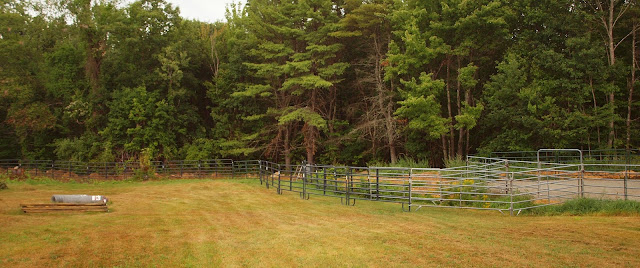It's been a few weeks since I had the york raking done, and I'm ready to lay out the first part of the track for fencing. At my last house people good-naturedly teased me about my abundance of fence.
I loves me a good fence.
I'm not a huge fan of electric fence for livestock; I like it for sections of pasture where the mules will be for short amounts of time, like the grazing pasture, but for a permanent paddock area I prefer a permanent fence. When we lose power (which we inevitably do), I don't want to hinge my bets on a non-electrified electric fence to keep in any kind of livestock. I've had a few loose animals in the past, and it's not as much fun rounding them up as Funniest Home Videos would have you believe.
So, my fence. I'm using a combination of pipe panels and pressure treated posts with no-climb horse fence. I began by setting up my "chute"; the alley from the main paddock to the track. I had planned to do the outer fence in the woven wire, and the inner fence in pipe panels, but I quickly ran out of pipe panels.
I still need to go along and set T-posts at every other junction to reinforce the panels. I had quite a nasty surprise in the last four panels I set up. I'd dragged them out into the pasture months ago and piled them up, and apparently hornets decided the hollow pipes were a perfect place to build a nest. Luckily I was only stung once before I figured it out. You know, for an old fat chick I can really haul ass when I need to.
Once that was done and I knew how far my panels would go, I dragged out my step in posts and started working on where I wanted the rest of the fence. I love those posts; I bought them through Amazon Warehouse and got a great deal. They are like the duct tape of posts - so handy, so useful, so easy. Not something I'd use permanently, but I love them for roping off newly seeded lawn, supporting taller plants in the garden, and blocking off temporary areas in the grazing pasture. They're easy to put in, easy to move around, and easy to remove. The clips worked perfectly to hold my measuring tape, and I was able to set them every 10 feet. After adjusting for gates in various spots, I had a good roadmap set up and was ready to start digging.
At my last house I dug every single fence post hole by hand. The result? Nice looking fences. Also, worsened back issues, a wonky upper rib, smashed fingers, and tendonitis in both elbows that still bothers me to this day. Digging in New Hampshire is no walk in the park thanks to the abundance of stone in our soil. My mom's farm is called Stoneridge Farm, an homage to the widespread ledge and boulders that live beneath the Earth's crust on this tiny 8 acre plot. Dig holes with a manual post hole digger, pry bar, and shovel? Thanks, but no thanks. Instead I once again enlisted the services of Corey from CMP Home and Property Maintenance. Corey came over with his tractor powered post hole digger and was able to dig 3 holes before something inside it blew. I think we both knew that was coming. He ended up digging 52 of the 55 holes with his backhoe.
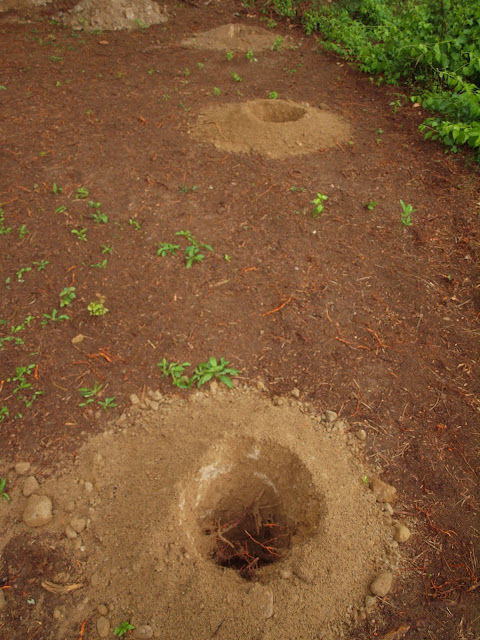 |
Perfect machine drilled holes...
|
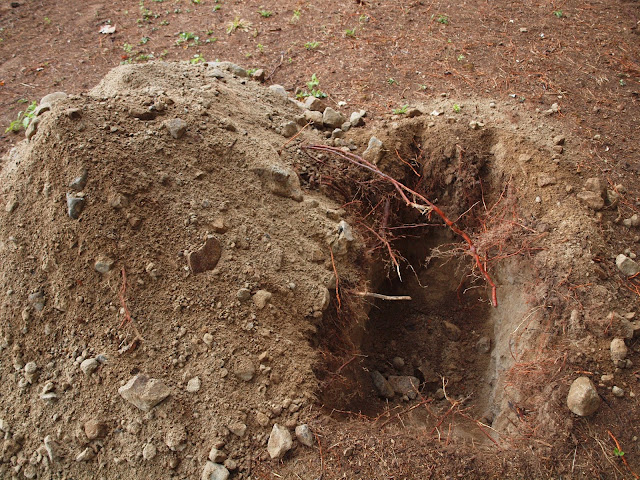 |
Backhoe dug holes...still better than digging by hand!
|
 |
You can see some of the roots and larger stones that would have made this a hellish task.
|
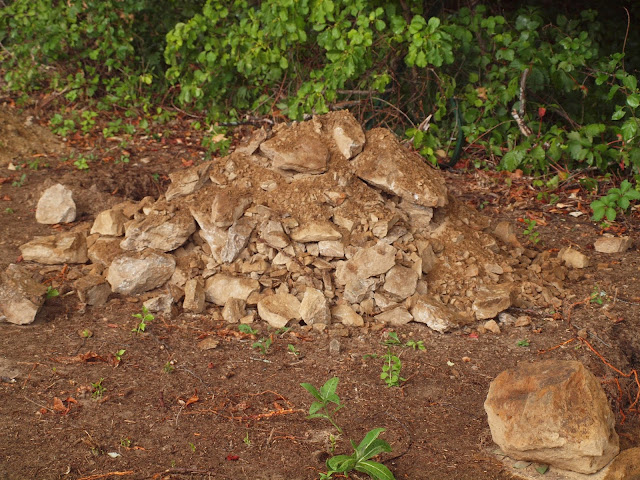 |
Ugh. Mostly rocks. That should be NH's nickname, not "The Granite State".
|
I had Corey dig holes for two sections; one is the upper section, the other is "The Oaks". I needed to be able to close off that section when the acorns rain down upon us. Acorns contain tannic acid that is toxic to equines if eaten. And of course, my mules will run straight for them, chowing down like it's a free continental breakfast buffet and there's only fifteen minutes left before they need to check out of this Hyatt Regency.
Behind The Oaks is The Land of the Lost Riding Ring. I helped my mother build part of the ring years ago, and it was used infrequently by us and her boarder. Over the years it's grown up and now a small pine grove harbors secrets of horse and mule training past.
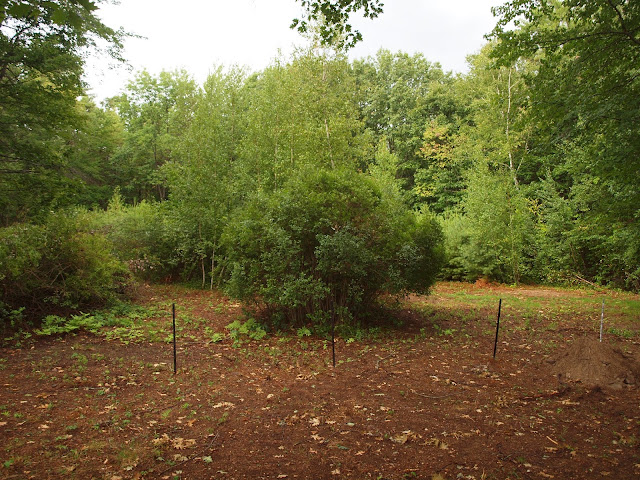 |
The old riding ring is behind this mess.
|
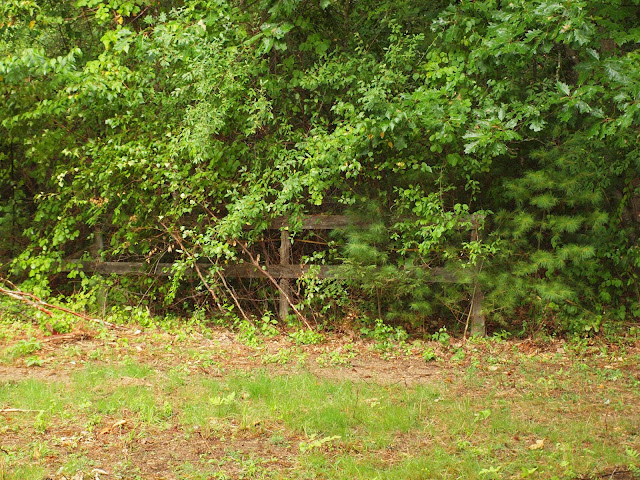 |
I can use this fence...if I can get the forest to let it go.
|
 |
A cone from obstacle course training. There are barrels in here somewhere, too, from Kelsey's barrel racing practice.
|
I'm hoping at some point I can tackle the ring area, and possibly the woods beyond. There's a lot of land here that hasn't been used at all. But for now, I have 55 posts to put in, hundreds of feet of fence to get up, and lots of bitching to accomplish while I'm doing it.
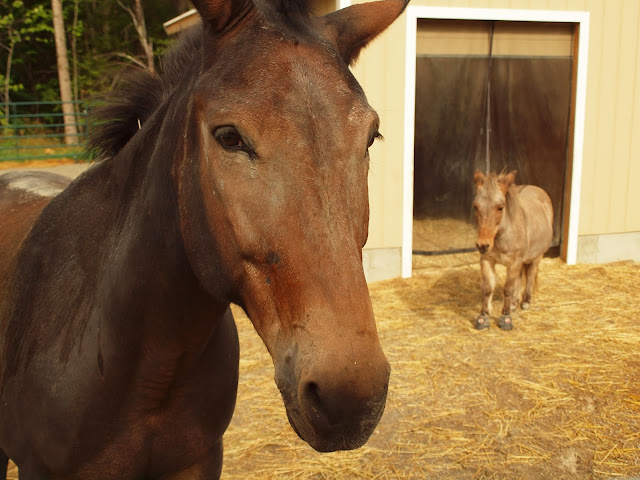 |
Let's get the lead out, Mother.
|
